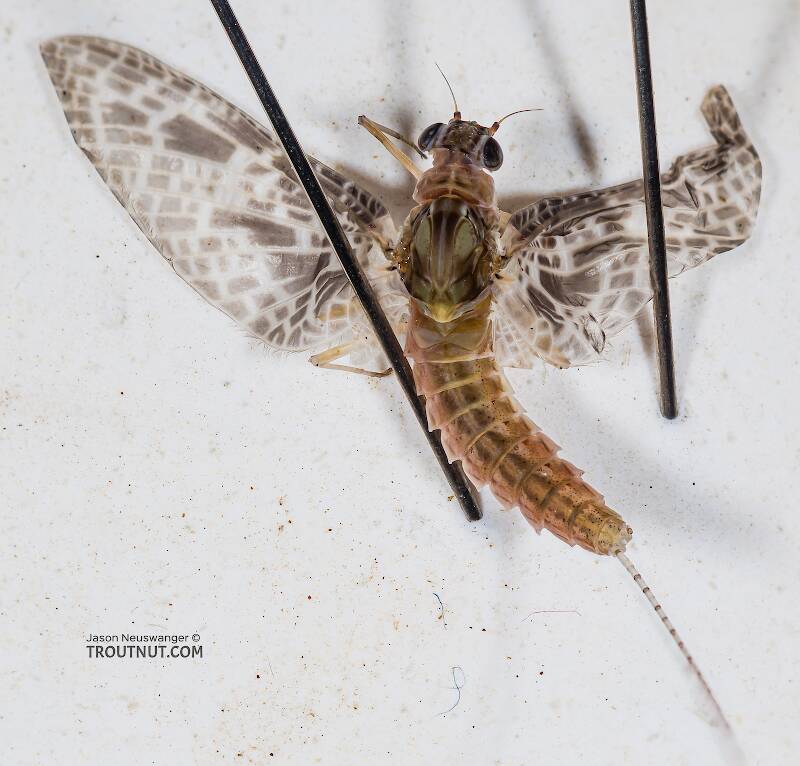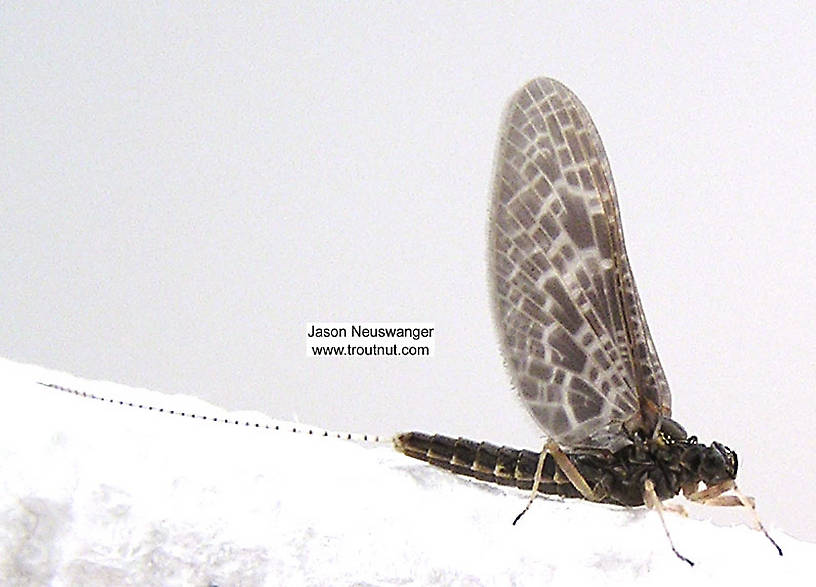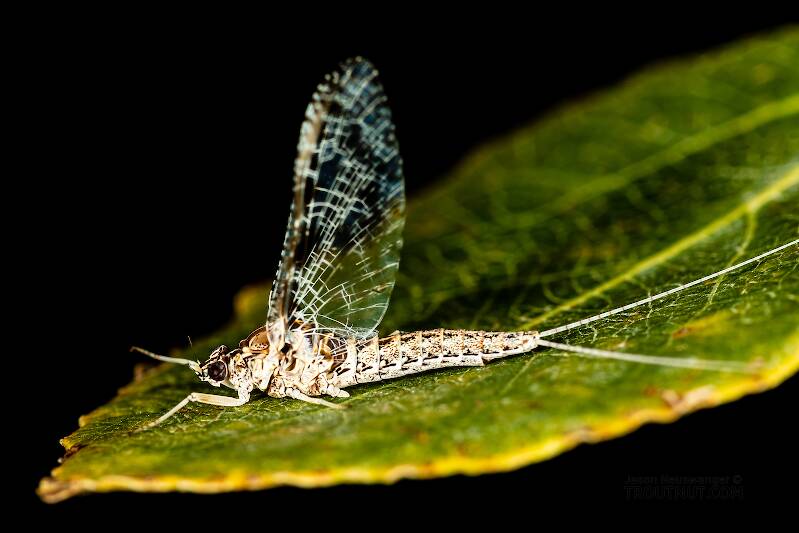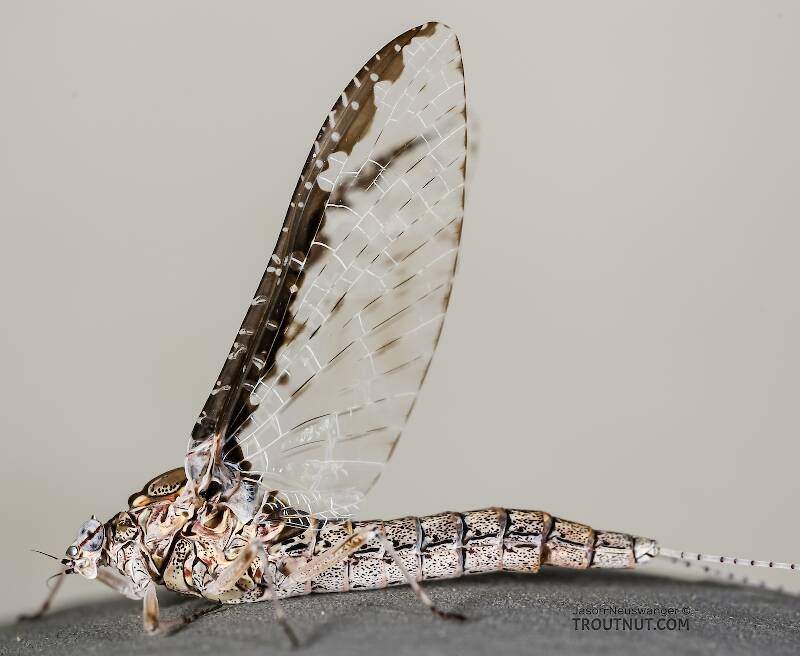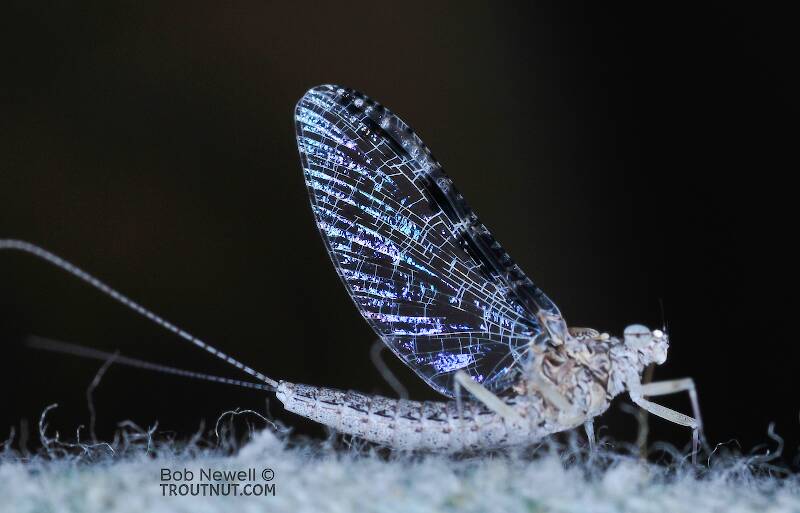
Salmonflies
Pteronarcys californica
The giant Salmonflies of the Western mountains are legendary for their proclivity to elicit consistent dry-fly action and ferocious strikes.

Mayfly Species Callibaetis ferrugineus (Speckled Duns)
Where & when
Because this taxon is the combination of what were once thought to be a variety of different species, previously published hatch charts are unreliable unless they are related to a particular region. Different books dealing with one synonym or another give a variety of different dates, colors, and sizes, basically showing that this species may be found through most of the season and in a variety of configurations. It usually produces two broods but can produce three in regions of the West with a longer growing season, and the angler should consult local hatch charts for their peak times and other relevant information.In 110 records from GBIF, adults of this species have mostly been collected during June (24%), July (20%), August (17%), May (15%), April (9%), and September (6%).
In 134 records from GBIF, this species has been collected at elevations ranging from 33 to 12402 ft, with an average (median) of 4836 ft.
Species Range
Hatching behavior
Spinner behavior
Time of day: Mid-morning or mid-evening
Nymph biology
Current speed: Slow
Substrate: Vegetation, silt
Environmental tolerance: Does well in cold water
Physical description
Most physical descriptions on Troutnut are direct or slightly edited quotes from the original scientific sources describing or updating the species, although there may be errors in copying them to this website. Such descriptions aren't always definitive, because species often turn out to be more variable than the original describers observed. In some cases, only a single specimen was described! However, they are useful starting points.
Male Spinner
Wing length: 7-10 mm
A reddish species; cross veins of fore wing numerous; marginal intercalaries paired; wing of male not pigmented. See frontispiece.
The two basal joints of the antenna each slightly fuscous at the tip; antennal filament whitish at base, fuscous at tip, in most specimens. Head and thorax ferruginous. “Anterior mesothoracic lobe subtruncate, the corners rounded.” Thoracic sternum pale, generally speckled with reddish brown. Legs pale yellowish; tips of the tibiae, the tarsal joinings as well as the tips of each joint, and the basal tarsal joint of the fore leg, fuscous. Wings hyaline; costa a little yellowish; veins of the costal margin yellowish, and a few of the other longitudinal veins often tinged with fuscous; veins and cross veins moderate, subequal, hyaline. There are numerous cross veins in the hind wing. Abdominal tergites densely freckled with reddish brown, sometimes almost piceous; venter paler, reddish white, less densely freckled. Forceps and tails whitish.
Described as C. carolus
Body length 8 mm, wing length 8 mm
A brown species; cross veins in fore wing numerous; marginal intercalaries variable, single or paired; wing of male usually very slightly pigmented.
Turbinate eyes of male orange-brown. Head red-brown. Basal joints of antenna pale, black apically; filament smoky brown, pale at extreme base and at tip. Thorax red-brown, notum reddish brown; pleura with paler yellowish areas, some of which are stippled. Fore leg brownish; in some specimens, femora yellowish except at apex, tarsi distinctly pale; in others, entire leg smoky to pale red-brown; femur with distinct pre-apical dark band. Middle and hind legs whitish or yellowish white; faint traces of a dark band near apex of femur, and occasional dark longitudinal streaks; stippling, if present, very faint; femoro-tibial joint and tarsal joinings darker; tarsi more or less shaded with light brown. Wings hyaline, iridescent; cross veins numerous; marginal intercalaries variable, usually paired in male, often single in female. Wing of male usually with faint blackish-brown markings along the costa, quite variable in extent; extreme apical portion of costal space shaded with brown. In well marked specimens, longitudinal veins are brown with many pale areas; cross veins pale, outer margin brown.
Abdominal tergites of male rather dark red-brown, the apical margins darker; dark submedian streaks, usually separated by a narrow pale mid-dorsal line; dark line along pleural fold; stippling moderately dense and regular. On each side of the dark submedian streaks is a paler yellowish streak, which on the apical tergites may extend over most of the lateral area. Sternites paler, yellowish brown, with the usual dark submedian streaks; stippling somewhat finer than on dorsum; apical sternites often opaque creamy or yellowish white. Forceps and tails yellowish or whitish, tail joinings distinctly but narrowly blackish.
Described as C. fuscus
Body length 8 mm, wing length 10 mm
A brown species; cross veins numerous (?) in the fore wing; wing of male pigmented.
Thorax brown, with some pale areas; some of these are dark-freckled. Femora of middle and hind legs distinctly banded; fore femur less distinctly so. Fore wing in both sexes “with liberal pigmented areas at front margin as far back as the radius; cross veins all along the costal space.” Numerous cross veins in the hind wing, which is pigmented at the base, as far as the costal projection. Abdomen of male “with light ground color and dark stippling, about equally dense on all segments.” Irregular light and dark areas on the tergites; a dark stripe along the pleural fold; on each sternite a pair of large dark submedian markings. Female described as very similar to male in coloration, except for usual sex differences.
Described as nigritus
Body length ? mm, wing length 9-9.5 mm
Body dark brown; cross veins in fore wing numerous; marginal intercalaries occur mostly in pairs; wing of male very slightly pigmented.
Body dark brown, thoracic notum blackish. Fore leg very dark, more or less blackish; middle and hind legs pale, the femora darker before the apex, tarsi wholly darker; femora very finely and equally freckled. Cross veins in fore wing numerous; intercalaries seem to occur mostly in pairs. Wing hyaline; longitudinal veins white with some black streaks; cross veins mostly pale; outer margin alternately dark and pale. “Costal area marked with black (not brown) spots, but not forming a continuous streak; various dots along costal margin, streaks along veins and larger spots beyond the middle, two being larger than the others” (Banks). Abdominal tergites with a darker median stripe, which “on the last few segments is pale in the middle.” A pair of dark submedian streaks on each sternite. Forceps and tails pale yellowish.
Female Spinner
Wing length: 7.5-12 mm
According to Dr. Banks, the costal band on the wing of the female is light brown, covering the basal costal space; many of the cross veins fenestrate with hyaline; posterior margin with three principal indentations and two smaller ones near the tip; veins brown in parts. The femora are said to be thickly spotted with light brown, and tarsi and tails marked with brown. From the original description, however, the tails would seem to be unmarked, and femoral freckles, if present, inconspicuous.
Described as C. carolus
Body length 8 mm, wing length 8 mm
Head and thorax of female yellowish brown; two longitudinal brown streaks on vertex, with a darker dot at center on each side, another at posterior margin; dark streaks extend backward as submedian marks on pronotum. Thoracic notum yellowish-in anterior and central portions; middle of scutellum yellow; postero-lateral margins of mesonotum dark red-brown. Legs whitish or yellowish, tarsi usually wholly brownish; femora usually with some reddish brown stippling. Vitta of wing blackish-brown, including basal costal space except basad of costal brace; this brace is brown at each end and pale in the middle, as in C. americanus (now a synonym of Callibaetis ferrugineus), and on each side near the subcosta is a brown cloud; costal space interrupted brown and white; vitta rather narrow, quite variable, but its posterior margin usually with four distinct lobe-like extensions, separated by wide pale areas; the most apical of these extensions has three or more small secondary lobes. Cross veins in vitta fenestrate with hyaline. Hind margin of wing alternately brown and white; small clouds often present along some of the veins, also on margin around the intercalaries. Longitudinal veins as in male.
Abdomen of female somewhat paler, otherwise similar to the male.
Described as C. coloradensis
Body length 7 mm, wing length 7.5 mm
A dark brown species, the body almost blackish; cross veins of fore wing numerous.
Head and thorax of female dark brown. Femora finely stippled with brown; tips of tarsi brown. Cross veins of wing numerous; marginal intercalaries paired ?. Vitta dark brown, “broken up into three principal spots, one, the largest, apical, one pterostigmatical, one before the middle, and a smaller one at base; basal costal space hyaline; the longitudinal veins are in places slightly marked with brown” (Banks). Most of the cross veins are white. Hind wing rather long and moderately narrow, the costal border somewhat emarginate behind the basal projection; marginal intercalaries long, more like longitudinal veins than intercalaries, 3 or 4 in number (from MS notes by J. G. N. on the type specimen); cross veins tend to be arranged in groups of two. Abdomen dark brown, almost blackish; shorter proportionately “than in other species of this section” (Banks). Tails missing from type specimen, not mentioned in description.
Described as C. hageni
Body length 12 mm, wing length 12 mm
Body piceous; cross veins of fore wing numerous; marginal intercalaries paired; male wing very slightly pigmented.
Body piceous; in female, the dorsal sutures of the thoracic notum are paler, yellowish; darker in the male, polished. Legs brown, in both sexes; femora "densely, minutely and inconspicuously dotted” (Eaton). Cross veins numerous in fore wing; intercalaries mostly in pairs, occasionally single. Vitta of female wing quite wide, dark brown, its hind margin with about 5 lobes. According to Dr. Banks, the second lobe extends back on wing further than in other species of this group. Cross veins in the vitta fenestrate with hyaline;-behind the vitta, along the veins, are about 3 rows of brown spots or clouds, “following and lying between the three main series of cross veins” (from MS notes by J. G. N.); the middle row of these spots is largest. Basal costal space included in vitta; longitudinal veins interrupted brown and white; outer margin of wing alternately brown and white; intercalaries brown, sometimes in a faint brownish cloud; cross veins mostly white. Stigmatic cross veins few, aslant; in the female fenestrate, more or less so in the male, but fainter in that sex. Wing of male almost clear—with two narrow brown widened portions on the costa; stigma slightly brown-tinged.
Abdomen “discolored” (in our Oregon specimen, deep reddish brown, almost blackish dorsally, only slightly paler ventrally); thickly dotted above and below. Tails white, joinings blackish.
Specimens of the Mayfly Species Callibaetis ferrugineus
1 Male Dun
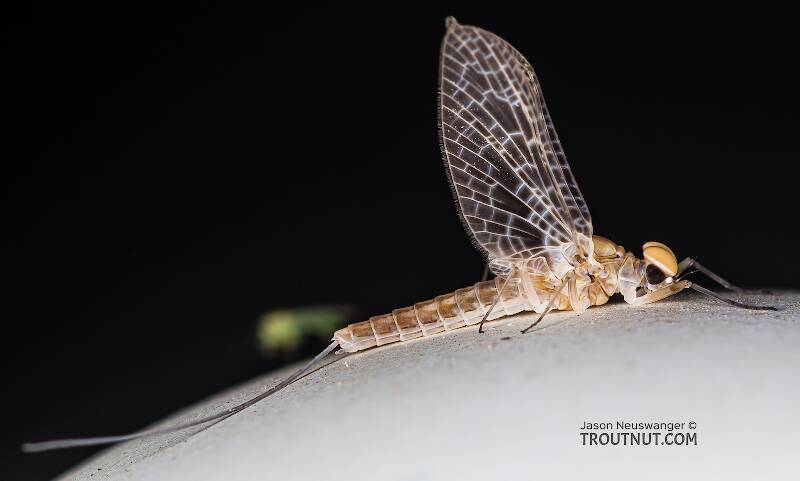
2 Female Duns
1 Male Spinner
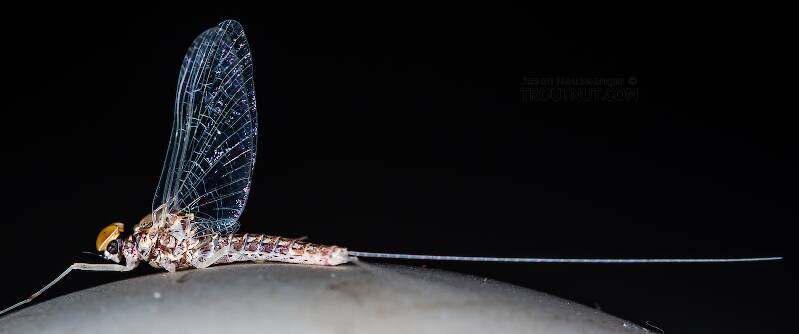
3 Female Spinners
1 Nymph
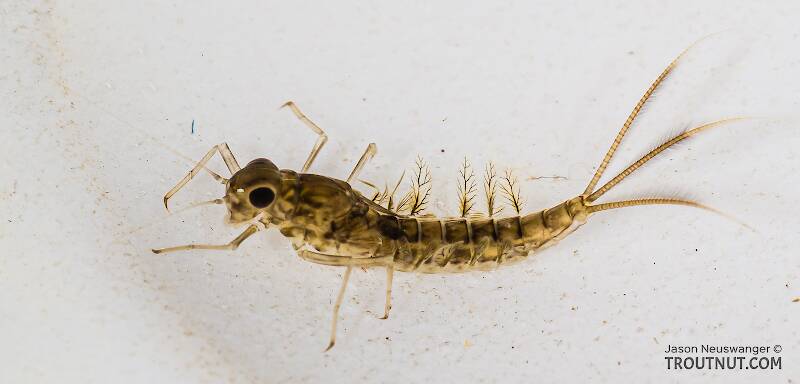
This nymph keys to either Callibaetis ferrugineous or Callibaetis pallidus. The lack of a darkened preapical band on the femora would suggest pallidus, but I can't definitively make out the "single seta" on the outer, ventral apex of any of the tarsi, the length of which is supposedly a more reliable characteristic to tell the species spart. I can maybe make something out on one of the legs at the highest magnification, and its dimensions would suggest ferrugineous.
Discussions of Callibaetis ferrugineus
Any comments? Hopefully contradictions?
Rob
Start a Discussion of Callibaetis ferrugineus
References
- Caucci, Al and Nastasi, Bob. 2004. Hatches II. The Lyons Press.
- Leonard, Justin W. and Fannie A. Leonard. 1962. Mayflies of Michigan Trout Streams. Cranbrook Institute of Science.
- Needham, James G., Jay R. Traver, and Yin-Chi Hsu. 1935. The Biology of Mayflies. Comstock Publishing Company, Inc.
- Schwiebert, Ernest G. 1955. Matching the Hatch. MacMillan Publishing Company.
- Swisher, Doug and Carl Richards. 2000. Selective Trout. The Lyons Press.
Mayfly Species Callibaetis ferrugineus (Speckled Duns)
Species Range
Resources
- NatureServe
- Integrated Taxonomic Information System
- Global Biodiversity Information Facility
- Described by Walsh (1862)



